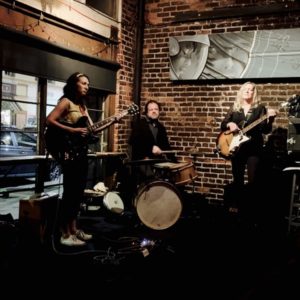
Re-Making History
In name, Highland Park’s York on York Boulevard might elicit thoughts of storied Yorkshire, England; or dandy Dukes; or a certain American colony taken from the Dutch in 1664. Highland Park itself, annexed to Los Angeles in the late 19th century, became one of L.A.’s first subdivisions (if newly-hip). Entering The York last night, with Jay Bellerose’s World War II-era wooden lug and rim drums on the corner stage; and sitting bar-side through two masterful sets of music evoking elements of Spanish Flamenco, Brazilian samba, Mississippi blues, St. Louis ragtime, New Orleans Dixieland, early American swing and rock n’ roll…history—giant-screen glowing in the background be damned!—was in the air.
But, much as old York of Yorkshire was transplanted in spirit as New York of America, stylistic origins were transported and transformed into something uniquely new at the hands of Bellerose, guitarist Molly Miller and bassist Jennifer Condos—known collectively as the Molly Miller Trio.
Those seats on the stage-side of the over-large island-style bar centered amidst the otherwise good-sized room, offered a straight-on view of the musicians and their woody (and hollow-bodied, in the cases of Molly and Jen) instruments. The music began simply and almost imperceptibly; it soon became impossible to ignore. In lesser hands this might have become justifiable background music. This was to be a musical event.
One, Two…
Miller is an established L.A. musician, recording and touring with artists such as Jason Mraz and The Black Eyed Peas, and chairing the Guitar Department at Los Angeles College of Music. Standing onstage, casually dressed—sock-less with color-coordinated hair band—she strikes an unassuming figure; but after the count-in, even at a background-level dynamic, her animated body language is disarmingly confident and impassioned, and her sound is unfailingly committed and ferocious, actually—melodic contours are seamlessly smooth, and rhythmic phrasing deliberate and sharp.
Condos, a long-standing partner (both musically and personally) of Bellerose, cast a more subdued physical presence onstage—eyes mostly closed, and contained to an economical right foot/left foot footprint—but is every bit as energized and consummate musically. Her credentials—including Ray Lamontagne, Stevie Nicks, Ryan Adams, Warren Zevon, and Sam Phillips—speak to her professional appeal, but also surely contribute to a nothing-to-prove generosity in her approach to both instrument and music-making.
Three…
Although Jay Bellerose’s L.A.-era (moving here from the Boston-area around twenty-years ago) predated my own by a good five-years, I only first became aware of him through his association with Robert Plant and Alison Krauss in 2007. Admittedly, it wasn’t until after his phenomenal performance on Ray LaMontagne’s 2010 breakout album, God Willin’ & The Creek Don’t Rise that I first heard him play locally. I now make a point of seeing him as often as possible, and this particular trio has been on my radar since its inception in 2017.
It’s difficult to separate hearing Bellerose play from seeing Bellerose play. Of course, it’s a joy listening to his drumming on Raising Sand or God Willin’…; but it can also be somewhat baffling. As drummers, it’s generally pretty natural to visualize a recorded performance in the mind’s eye. We can easily see Gadd or Bonzo or Charlie, for example, with our ears; great drummers all, their relatively familiar approaches to the instrument largely look like they sound and sound like they look.
Bellerose’s approach to the instrument is singularly unfamiliar. To hear him without sight or see him without sound invites mystery: kind of like standing too close to (or far away from) a Chuck Close painting—you know it’s something special, but…what’s going on, exactly?
His regular use of unusual, rare or found drums and percussion; and varied, unorthodox implements; along with channeled, nonlinear albeit focused composition, blur the lines between conventional drumset and ensemble percussion, improvisation and orchestration.
A brief amalgam from this show:
A seemingly ever-present wooden tambourine is carefully positioned atop the hi-hat rod. Stick under arm, the tambo is taken in left hand for a single jingle-trill, or maybe a 16th pulse for a phrase; before being carefully returned to its perch. A maraca is picked-up and played along with stick in right hand just above the ride cymbal. A mallet strike on a shell-less compact conga placed on the floor to the right-rear. Leaning over, a smooth two-handed roll on the resonant bass drum head. Ankle shaker on left foot.
Maybe this was all over two to three pieces, but it could well have been one. Or, maybe it’s simple and relentless, round, fluid brushwork on the snare, beginning to end.
If Bellerose, the musician, has a mission statement, it might be this: Whatever it takes, in the moment, to achieve percussive bliss as the music desires.
However unexpected, the result, much like his signature cardigans, is warm, cozy and inviting; relaxed yet dignified; and perennially in style.
…More!
Together, The Molly Miller Trio transformed musical styles while transcending themselves as musicians. It’s the mark of any highly functioning and achieving band of creators, really, and begs the old axiom: greater than the sum of its parts. This from a trio of three extraordinary parts.
It was a very L.A. night of music. I know you can find world-class musicians in the darkest nooks of New York City; but perhaps because of the more sprawling (man-made) nature of L.A., our particular and prolific community of world-class musicians can be found more regularly, in more widespread nooks on any given night. All these years later and it still feels remarkable. For most cities in-between, the quiet bar-band in the corner plays background music; and the likes of The Molly Miller Trio is a bona fide night-out.
